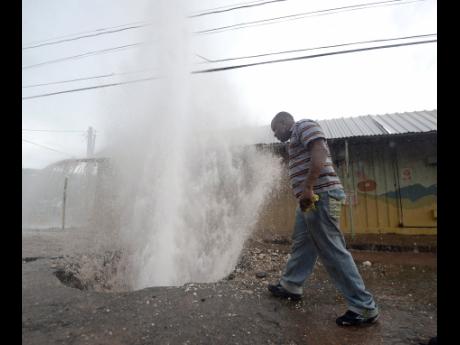Puzzled by higher water losses, OUR seeks to audit NWC’s K-Factor
The National Water Commis-sion (NWC) loses over 100 billion litres of water a year to leaks.
This could fill the Mona and Hermitage dams 20 times, or fill the country's tallest building, The Jamaica Pegasus hotel in Kingston, 1,250 times. Put another way, what the NWC loses to leaks in a week is more water than Red Stripe uses to make all its beer each year, and more water than the entire population drinks in 12 months.
What's more, the utility loses a similar amount of water to under registering meters, theft, bypass, and social usage, such as water at fire hydrants.
Even more puzzling is that after the utility spent $17 billion to reduce non-revenue water - the volume of water produced, but not billed - increased from 62 per cent of all the water treated, produced and flowed into the island wide network of pipes and pumps in 2008 to 70 per cent last year.
A quick look at the numbers show that billed consumption fell by around 10 per cent between 2009 and 2014, while production declined by a marginal one per cent. A severe drought in 2014 was to be blamed for the lower output, but it is not clear why there was a disproportionate reduction in paid-for consumption.
The Office of Utilities Regulations (OUR) has now issued a request for proposals for conducting a management and operation audit of the NWC's K-Factor programme. Qualified consultants have up to April 6 to submit bids.
The K-factor was a tariff introduced to water bills in 2008 to generate funds for the NWC that would be placed in a special account against which the utility could secure loans for eligible capital projects.
Key targets for these projects included the reduction of non-revenue water to below 50 per cent by 2013 and expand the wastewater collection network to reduce the average cost at the Soapberry Wastewater Treatment Plant.
K-Factor projects
The NWC has spent more than $19.5 billion on K-Factor projects since 2008, but the OUR says it has not been able to quantitatively assess the impact of the programme, and particularly the completed projects on the NWC's operations in terms of the stated K-Factor objectives.
Thus, the audit is meant to assess the overall effectiveness and efficiency of the programme.
Reducing water leaks would go a long way towards eliminating the NWC's financial woes. The utility conservatively loses upward of $2 billion a year, has no capital base to speak of and has debt totalling over $70 billion, which is more than the GDP of Dominica.
It cost the company about $17 billion to produce and treat near 300 billion litres of water last year, or less than six cents a litre, but it only billed for 30 per cent of that volume, and collected even less. Conceivably, if the utility had successfully hit its target in 2013, it could have lowered overall cost by some 12 per cent, that is, it perhaps would have spent $2 billion less on water production while generating the same amount of revenue last year.
$5.1b project
Outside of the K-Factor programme, last July, the NWC inked a deal with an Israeli-owned firm, Miya, to reduce water losses in Kingston and St Andrew.
The US$42.5 million ($5.1 billion), Inter-American Development Bank (IDB) project aims to cut non-revenue water in the Corporate Area from 54 per cent to around 37 per cent within two years, to 30 per cent by year three and 20 per cent by year five.
That would translate into daily savings of 70 million litres of water and potentially result in annual cost reduction equivalent to over $1.4 billion today.

